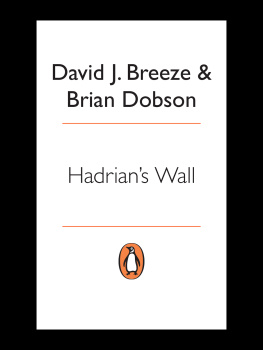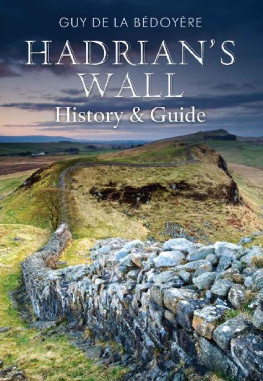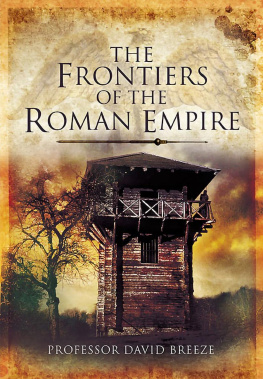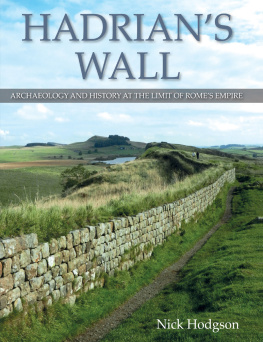PENGUIN BOOKS
HADRIANS WALL
Brian Dobson was born in 1931 at Hartlepool, educated at Stockton Grammar School and Durham University. He stayed firmly at Durham (as Staff Tutor, later Reader, in Archaeology in the Department of Adult and Continuing Education) apart from National Service and two years at Birmingham University, concentrating on the Roman army and on Hadrians Wall. He has now retired.
David Breeze, born in 1944, was educated at Blackpool Grammar School and at University College, Durham, and is now Chief Inspector of Ancient Monuments in Scotland. He has excavated extensively in North Britain and written books and articles on Roman archaeology and the Roman army. He is married with two sons and lives in Edinburgh.
DAVID J. BREEZE AND BRIAN DOBSON
HADRIANS
WALL
Fourth Edition

PENGUIN BOOKS
To Pamela and Anne
PENGUIN BOOKS
Published by the Penguin Group
Penguin Books Ltd, 80 Strand, London WC2R 0RL, England
Penguin Putnam Inc., 375 Hudson Street, New York, New York 10014, USA
Penguin Books Australia Ltd, 250 Camberwell Road, Camberwell, Victoria 3124, Australia
Penguin Books Canada Ltd, 10 Alcorn Avenue, Toronto, Ontario, Canada M4V 3B2
Penguin Books India (P) Ltd, 11 Community Centre, Panchsheel Park, New Delhi 110 017, India
Penguin Books (NZ) Ltd, Cnr Rosedale and Airborne Roads, Albany, Auckland, New Zealand
Penguin Books (South Africa) (Pty) Ltd, 24 Sturdee Avenue, Rosebank 2196, South Africa
Penguin Books Ltd, Registered Offices: 80 Strand, London WC2R 0RL, England
www.penguin.com
First published by Allen Lane 1976
Second edition published in Pelican Books 1978
Third edition 1987
Fourth edition 2000
Copyright David J. Breeze and Brian Dobson, 1976, 1978, 1987, 2000
All rights reserved
The moral right of the authors has been asserted
Except in the United States of America, this book is sold subject to the condition that it shall not, by way of trade or otherwise, be lent, re-sold, hired out, or otherwise circulated without the publishers prior consent in any form of binding or cover other than that in which it is published and without a similar condition including this condition being imposed on the subsequent purchaser
ISBN: 978-0-14-194155-4
CONTENTS
LIST OF PLATES
The authors and publishers would like to thank the following for supplying photographs for use in this volume:
Committee for Aerial Photography, Cambridge University, ;
Mr P. Connolly, ;
English Heritage, ;
Historic Scotland, ;
Dr V. A. Maxfield, ;
Newcastle upon Tyne Museum of Antiquities, ;
Turners Ltd, Newcastle upon Tyne, ;
Tyne and Wear Museums Service, .
LIST OF TEXT FIGURES AND MAPS
.
N.B. Small forts in the figures and text mean forts too small to hold a complete unit; fortlets denote forts too small to hold more than a century. This can only be a rough classification.
LIST OF TABLES
NOTE ON MEASUREMENTS
All measurements are given in modern miles and feet, with metric equivalents, except where Roman measurements are specified. The Roman foot was half an inch shorter than the modern foot:
1 Roman foot = 11 modern inches (292 mm)
1 Roman mile = 1686 modern yards (1.54 km)
PREFACE
The number of books on Hadrians Wall has multiplied disconcertingly of late. Nevertheless there still seems a place for a book concerned above all with the history of the Wall. This book therefore is not a guide to the Wall nor is it a description in detail of the actual physical remains. It is an attempt to review the evidence for the best-known and best-preserved of all Romes artificial frontiers in order to explain why it was built at a particular time on a particular line across Britain, and to follow its history till the end of Roman control in Britain.
The book starts therefore with a condensed history of Roman Britain and the Empire up to the decision to build Hadrians Wall, concentrating on Roman thought about frontiers in general and Romes aims and objectives in Britain in particular. Next the building of the Wall is examined in detail, using a variety of evidence which allows some reconstruction of the planning and timetabling of the project. The following chapter deals with the abandonment of Hadrians Wall, still in process of modification, for a new Wall in Scotland. This, the Antonine Wall, is examined in depth to see the differences and similarities between the two Walls. In the next chapter the later history of these Walls till the final abandonment of the Antonine Wall and the return to Hadrians Wall is discussed and the new arrangements for controlling the northern frontier considered.
There is a natural pause at this point in the story. In the third century the northern frontier saw an era of peace broken by the first appearance of the Picts (under that name at least) and the Scots at the end of the century. These new dangers of the fourth century lead to a completely different situation from that of the first and second centuries. The fourth century also sees a complete reorganization, civil and military, of the administration of the Empire, and a complete change in the organization of the army. The tranquil interlude of the third century and the turbulent fourth century are therefore discussed after two general chapters on the organization of the army and life in the forts, which apply to the first, second and third centuries A . D ., and to some extent to the fourth.
These two chapters are divided rather arbitrarily, but the first, The Army of the Wall, is intended to give the basic organization of the units in the Roman army and the layout of the Roman fort. It also acts as a glossary for some of the discussion in the historical chapters which involves unit organization and the internal buildings in forts, such as the suggested garrisons for the Wall forts. The second of these chapters, Life on the Wall, is an attempt to show what life on Hadrians Wall was like, concentrating on the soldiers but not ignoring their dependants who created the vici, the villages outside the forts where soldiers families and traders lived. Some notes on the later developments in the army are appended here.
There follows a chapter on the third and fourth centuries, and a conclusion. Some matters have been relegated to appendices. A list of emperors and governors is given, for reference purposes, which supplements chronological tables in the text. The units which at one time or another were stationed in the forts of the Wall, its outposts and its Cumbrian coast flank, are listed by names of unit and by fort. There is a rather longer treatment of the gods worshipped on the Wall than would be possible in the main text without over-extending the chapter on Life on the Wall. Finally the places on the Wall are singled out where some of the features referred to in the text, details of construction or types of buildings in forts, may be most clearly seen.
It has already been said that this book is not a guide nor a gazetteer, nor can it be an exhaustive account of every aspect of the Wall. The purpose is to show how the Wall came to be, what it was and how it developed, how it influenced and was influenced by its alternative, the Antonine Wall, and what happened during its later history. Life on the Wall for the soldiers garrisoned there, and, as far as the evidence allows, for their dependants, is described in the light of evidence from the Wall and elsewhere. The bias is military, for the Wall was built and garrisoned by soldiers, though paradoxically its own purpose was bureaucratic rather than military, the establishment of a tidy method of controlling movement into and out of the Empire. The full effects of the Wall on the native peoples north and south of it, the full story of the civil settlements under its shadow, still remain to be discovered and recorded. Till these are known the story must be incomplete.
Next page










